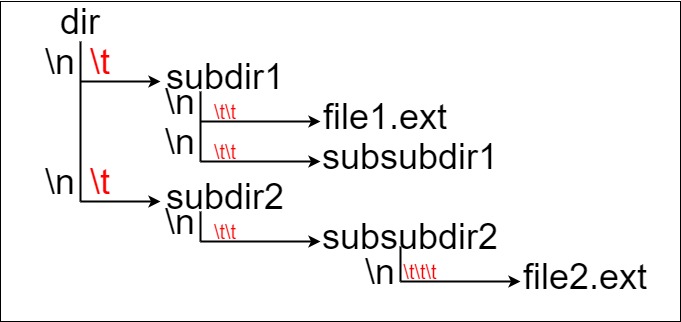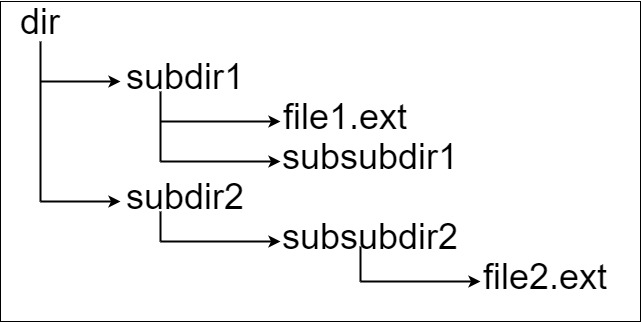Longest Absolute File Path
Suppose we have a file system that stores both files and directories. An example of one system is represented in the following picture:

Here, we have dir as the only directory in the root. dir contains two subdirectories, subdir1 and subdir2. subdir1 contains a file file1.ext and subdirectory subsubdir1. subdir2 contains a subdirectory subsubdir2, which contains a file file2.ext.
In text form, it looks like this (with ⟶ representing the tab character):
dir ⟶ subdir1 ⟶ ⟶ file1.ext ⟶ ⟶ subsubdir1 ⟶ subdir2 ⟶ ⟶ subsubdir2 ⟶ ⟶ ⟶ file2.ext
If we were to write this representation in code, it will look like this: "dir\n\tsubdir1\n\t\tfile1.ext\n\t\tsubsubdir1\n\tsubdir2\n\t\tsubsubdir2\n\t\t\tfile2.ext". Note that the '\n' and '\t' are the new-line and tab characters.
Every file and directory has a unique absolute path in the file system, which is the order of directories that must be opened to reach the file/directory itself, all concatenated by '/'s. Using the above example, the absolute path to file2.ext is "dir/subdir2/subsubdir2/file2.ext". Each directory name consists of letters, digits, and/or spaces. Each file name is of the form name.extension, where name and extension consist of letters, digits, and/or spaces.
Given a string input representing the file system in the explained format, return the length of the longest absolute path to a file in the abstracted file system. If there is no file in the system, return 0.
Example 1:

Input: input = "dir\n\tsubdir1\n\tsubdir2\n\t\tfile.ext" Output: 20 Explanation: We have only one file, and the absolute path is "dir/subdir2/file.ext" of length 20.
Example 2:

Input: input = "dir\n\tsubdir1\n\t\tfile1.ext\n\t\tsubsubdir1\n\tsubdir2\n\t\tsubsubdir2\n\t\t\tfile2.ext" Output: 32 Explanation: We have two files: "dir/subdir1/file1.ext" of length 21 "dir/subdir2/subsubdir2/file2.ext" of length 32. We return 32 since it is the longest absolute path to a file.
Example 3:
Input: input = "a" Output: 0 Explanation: We do not have any files, just a single directory named "a".
Example 4:
Input: input = "file1.txt\nfile2.txt\nlongfile.txt" Output: 12 Explanation: There are 3 files at the root directory. Since the absolute path for anything at the root directory is just the name itself, the answer is "longfile.txt" with length 12.
Constraints:
- 1 <= input.length <= 104
- input may contain lowercase or uppercase English letters, a new line character '\n', a tab character '\t', a dot '.', a space ' ', and digits.
Solution:
keep track of a list of current directories, update the list if we see less tabs than the length of list
class Solution {
/*
dir
\n\tsubdir1
\n\t\tfile1.ext
\n\t\tsubsubdir1
\n\tsubdir2
\n\t\tsubsubdir2
\n\t\t\tfile2.ext
*/
public int lengthLongestPath(String input) {
List<String> dirs = new ArrayList();
int max = 0;
int prevtabs = 0;
for (int i = 0; i < input.length();) {
int istart = i;
int tabs = 0;
while (i < input.length() && input.charAt(i) != '\n') {
i ++;
}
String file = input.substring(istart, i);
i ++;
while (i < input.length() && input.charAt(i) == '\t') {
i ++;
tabs ++;
}
if (dirs.size() > 0 && prevtabs < dirs.size()) {
dirs = dirs.subList(0, prevtabs);
}
// System.out.println(file + ", " + dirs + ", " + prevtabs);
if (file.contains(".")) {
int dirLen = 0;
for (String dir : dirs) {
dirLen += dir.length();
}
max = Math.max(max, file.length() + dirLen + dirs.size());
} else {
dirs.add(file);
}
prevtabs = tabs;
}
return max;
}
}